|
Zippo, The Windproof Lighter
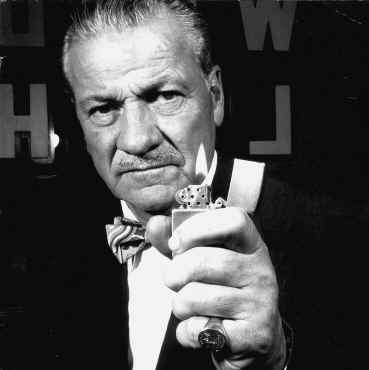 Zippo Manufacturing Company is world famous for its
Zippo windproof lighter, its lifetime guarantee, and the distinctive
"click" it makes when opened. Zippo Manufacturing Company is world famous for its
Zippo windproof lighter, its lifetime guarantee, and the distinctive
"click" it makes when opened.
Zippo originated in a small Pennsylvania town at a
time when the United States was in its worst depression in history.
Zippo's success came about through imagination and hard work and the
creation of a durable and functional product along with creative
marketing and attentive service.
It all started on a summer evening in 1932, at a
dinner dance held at the Bradford Country Club in Bradford,
Pennsylvania. Attending the dance was George G. Blaisdell. It is rumored
that Blaisdell and a friend stepped out on the terrace of the Pennhill
Country Club and there, he saw the friend trying to light up a
cigarette. The ugly lighter he was using was totally out of place in the
hand of his perfectly attired friend. It took two hands to operate the
lighter. The sight of his friend trying clumsily to open the lighter's
lid was so comical that Blaisdell almost started to laugh. "You're
all dressed up. Why don't you get a lighter that looks decent?"
blurted Blaisdell. His friend replied, "Well, George, it
works!"
Impressed with the fact that it worked, Blaisdell
decided to try to sell the lighters himself. He obtained rights to
distribute the product in the United States, imported them from Austria
for 12 cents each, and attempted to sell them for $1 each. This venture
failed, mainly because of the clumsy nature of the lighter's design.
Blaisdell then decided to design his own lighter, one that was
attractive, easy to use, and dependable.
The first thing Blaisdell did was to make the lighter
smaller to be able to fit in the palm of the hand, and he incorporated a
hinge to hold the lid to the bottom, making it an integral part of the
lighter. This enabled the user to open the lighter using only one hand.
He kept the chimney design which protected the flame under adverse
conditions. The result was a lighter that looked good and was easy to
operate. Blaisdell liked the name of another recent invention, the
zipper, so he christened his lighter the "Zippo" and his new
firm, Zippo Manufacturing Company.
Production of Zippos began in 1933 in a $10 per month
rented room over the Rickerson & Pryde garage in Bradford. The shop
had $260 in equipment and two employees, from which came lighters
retailing for $1.95. The first Zippo lighter is currently displayed at
the Zippo/Case Museum in Bradford.
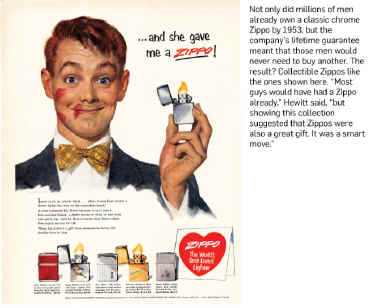 In the company's ledger at the end of the first
month, 82 units were produced and sales were $69.15. To market the new
product, Blaisdell came up with the practice of a lifetime warranty, a
concept that began with the first Zippo lighter and has remained the
same to the present day. The repair and sale of parts after the
expiration of the warranty was a major source of the business revenue. In the company's ledger at the end of the first
month, 82 units were produced and sales were $69.15. To market the new
product, Blaisdell came up with the practice of a lifetime warranty, a
concept that began with the first Zippo lighter and has remained the
same to the present day. The repair and sale of parts after the
expiration of the warranty was a major source of the business revenue.
Zippo repaired all types of defects without charging
a cent. The lighter was returned postpaid within 48 hours with a note
reading, "We thank you for the opportunity of serving your
lighter". The concept of a lifetime warranty became Zippo's primary
marketing scheme.
Sales of the lighters got off to a slow start, with
only 1,100 sold during the first production year. Blaisdell tried all
kinds of methods to move his brainchild. He gave away samples and gifts
to long-distance bus drivers, jewelers, and tobacconists. In December
1937 he paid $3,000 of mostly borrowed money for a full-page ad in
Esquire magazine after he found that retailers shied away from products
that were not advertised. Unfortunately, Blaisdell did not yet have
sufficient distribution to take advantage of the effect of such
advertising so this gamble failed to pay off.
While handling sales himself and struggling to
develop a market for his windproof lighter, Blaisdell also tinkered with
the design. The lighter was shortened by a quarter inch in 1933,
decorative diagonal lines were added in 1934, the hinge was placed on
the inside of the case in 1936, and rounded tops and bottoms replaced
the square corners of the original design in 1937. This last alteration
was important from a production standpoint as the lid and bottom could
now be formed as a whole, eliminating the soldering process.
Blaisdell achieved his first big sales break in 1934
when he started selling Zippos on punchboards, two-cents-per-play
gambling games popular in U.S. tobacco and confectionery shops,
poolrooms, and cigar stands. Before punchboards were outlawed in 1940,
more than 300,000 Zippos were sold through this game of chance, enough
for Zippo Manufacturing to achieve its first profits.
While punchboards were a short-lived chapter in Zippo
history, another of Blaisdell's marketing methods had a much
longer-lasting impact. In 1936 an Iowa life insurance company ordered
200 engraved lighters that it gave to its agents as contest prizes.
Bradford's own Kendall Oil Company ordered 500 engraved lighters for its
customers and employees. Thus began Zippo's specialty advertising
business, which would become an increasingly important venture in the
coming decades.
This was the beginning of the specialty advertising
business for the Zippo. Zippo Manufacturing Company discovered the
market potential of the product as an adverting medium. Soon, Zippo
produced a pamphlet aimed at corporations to use Zippo as a pocket
salesman. Designs such as the military, airplanes, tourists spots,
sports teams, comic characters and universities also appeared on Zippo's
lighters. Corporate novelty and commemorative lighters were produced
only in limited numbers. In essence, the Zippo lighters were the
salesman in a pocket.
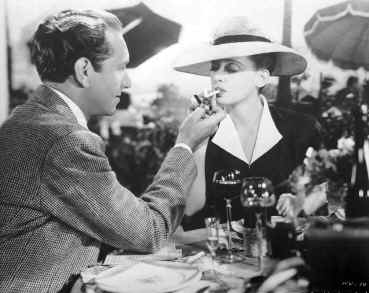 In 1936 Zippo began to engrave initials and providing
two types of metal insignia on the lighter, the "Scotty
Group", depicting dogs, and the "Drunk", portraying a
drunkard leaning on a gaslight pole. The engraving of the initials cost
the owner of the lighter one dollar, or 75 cents for an insignia. The
return shipment was paid by the owner, C.O.D. The initials were engraved
in a frame against a background color. The various colors include, red,
green, blue, yellow, orange, purple, and white. During the thirties and
forties, initialed gifts were very popular. It gave the consumer the
sense of individuality. In 1936 Zippo began to engrave initials and providing
two types of metal insignia on the lighter, the "Scotty
Group", depicting dogs, and the "Drunk", portraying a
drunkard leaning on a gaslight pole. The engraving of the initials cost
the owner of the lighter one dollar, or 75 cents for an insignia. The
return shipment was paid by the owner, C.O.D. The initials were engraved
in a frame against a background color. The various colors include, red,
green, blue, yellow, orange, purple, and white. During the thirties and
forties, initialed gifts were very popular. It gave the consumer the
sense of individuality.
In 1936, Zippo appeared on a mail-order catalog. It
was a wholesale catalog of a company in Minnesota directed to retail
stores. The retail price was $2.00, which increased slightly from the
price first sold. Blaisdell also visited many retail stores all over the
country to make business relations.
The sports related designs began to appear on the
Zippo lighters in 1937. The first sports model was the 275, which was
sold for $2.75. The 275 models with a carrying strap also appeared in
the Sports Series. Earlier sports models included the Golfer, the
Fisherman, the Bulldog, the Hunter, the Greyhound, and the Elephant. In
1938, the Scotch Terrier, the Fisherman and the Bulldog were the only
models on the Sports Series.
In 1937, Zippo ran a one-page advertisement in the
December issue of Esquire, aimed at the Christmas shoppers. The ad had
an illustration of a woman, "Windproof Beauty", drawn by Enoc
Boles, lighting up a cigarette in the wind. It was a different image
from the previous image, which emphasized outdoor sports. Using an
illustration of an attractive woman, the advertisers were aiming to
appeal directly to the readers of the magazine, which was targeted at
the urban male. The Windproof Beauty illustration was also used for
packaging and became one of Zippo's characteristic images. This was a
memorable advertisement for Zippo, the company would later run regular
advertisements in many major magazines such as Life, the Saturday
Evening Post, and Reader's Digest.
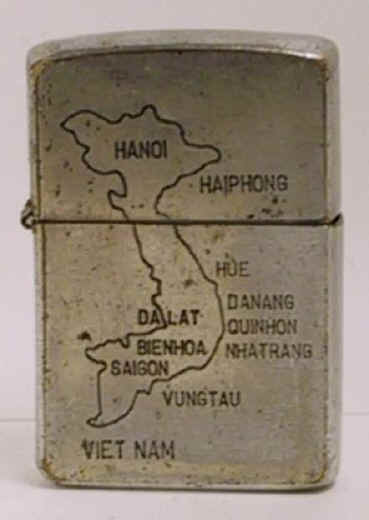 With sales increasing thanks to the punchboards and
the special markets deals, Blaisdell expanded his operations. First, the
production facility expanded into the entire second floor of the
Rickerson & Pryde building. In 1938 the factory and offices were
both moved into a former garage on Barbour Street in Bradford. That same
year, Zippo's first table lighter debuted, a four-and-a-half inch tall
model that held four times the fuel of a pocket lighter. Production of
the table lighter stopped in Oct 1941, but was made available again in
1947. In 1939 Zippo introduced a sophisticated new lighter model, the
14-karat solid gold Zippo, available in both plain and engine-turned
models. With sales increasing thanks to the punchboards and
the special markets deals, Blaisdell expanded his operations. First, the
production facility expanded into the entire second floor of the
Rickerson & Pryde building. In 1938 the factory and offices were
both moved into a former garage on Barbour Street in Bradford. That same
year, Zippo's first table lighter debuted, a four-and-a-half inch tall
model that held four times the fuel of a pocket lighter. Production of
the table lighter stopped in Oct 1941, but was made available again in
1947. In 1939 Zippo introduced a sophisticated new lighter model, the
14-karat solid gold Zippo, available in both plain and engine-turned
models.
With the onset of U.S. involvement in World War II,
the U.S. government forced the halt in production of many consumer
products. Blaisdell continued Zippo production, but as he had during
World War I, he again moved into government contracting, all Zippos
became destined for the U.S. military. With brass reserved for military
uses only, the wartime lighters were made of a low-grade steel. Since
this provided a poor finish, they were spray-painted black then baked,
which produced a crackle finish. The black, rough-surfaced Zippo is the
authentic World War II Zippo. The advantage of the black finish was that
it did not reflect light that would attract enemy attention on the
battlefield.
Blaisdell sold some of these Zippos to the military
post exchanges at such a low price that they were then resold for $1.00,
making them the most affordable lighter available. He also sent hundreds
of lighters to celebrities, including the famous war correspondent Ernie
Pyle who then gave them away to servicemen overseas. Pyle gave Blaisdell
the nickname "Mr. Zippo." Through these actions, the Zippo
became the favorite lighter of GIs, whose loyalty to the product would
help fuel postwar sales. Numerous war stories also helped cement the
Zippo as an American icon, the Zippo that stopped a bullet, that cooked
soup in helmets, that illuminated the darkened instrument panel of an
Army pilot's disabled plane, enabling him to land safely.
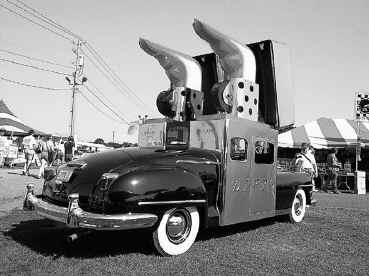 Zippo's rise to prominence during World War II is
reflected by the large number of films that featured Zippo lighters,
both those made during that period and afterward. Whether it's Donna
Reed lighting Montgomery Clift's cigarette in From Here to Eternity
or Errol Flynn wielding his Zippo in Objective Burma, a Zippo
lighter provided an instant air of authenticity. Director George Stevens
was captured using his Zippo during the making of his documentary D-Day
to Berlin. In 1945, Vincent Minelli's, The Clock, used a
lighter to bring Judy Garland and Robert Walker together for a whirlwind
courtship. The dialogue indicates that it is a Zippo lighter, but the
shortage of civilian Zippo lighters forced the use of a stand-in. Zippo's rise to prominence during World War II is
reflected by the large number of films that featured Zippo lighters,
both those made during that period and afterward. Whether it's Donna
Reed lighting Montgomery Clift's cigarette in From Here to Eternity
or Errol Flynn wielding his Zippo in Objective Burma, a Zippo
lighter provided an instant air of authenticity. Director George Stevens
was captured using his Zippo during the making of his documentary D-Day
to Berlin. In 1945, Vincent Minelli's, The Clock, used a
lighter to bring Judy Garland and Robert Walker together for a whirlwind
courtship. The dialogue indicates that it is a Zippo lighter, but the
shortage of civilian Zippo lighters forced the use of a stand-in.
The military connection extends through films about
the Korean War and Vietnam. A Zippo linked Karl Malden and Richard
Widmark in Sergeant Terror, while Gregory Peck counted on his
Zippo for moral support in Pork Chop Hill. The Green Berets,
starring John Wayne, was extremely popular. Apocalypse Now
director Francis Ford Coppola set the haunting tone of his film in the
opening scenes with Martin Sheen's Colt revolver and a Zippo lighter.
Meanwhile, wartime production peaked in 1945 when three million Zippos
were made.
The Zippo repair clinic became famous in its own
right by backing up the Zippo guarantee. Repaired lighters were returned
at no cost to the customer, not even return postage. The clinic provided
more than just customer goodwill. It also provided invaluable
information about design flaws. Over the long run, the repair clinic
found that a faulty or broken hinge was the most common reason for a
Zippo to be returned. But soon after World War II, in 1946, Blaisdell
discovered that the most frequent repairs were for worn striking wheels,
wheels that had been coming from an outside supplier. Blaisdell
immediately stopped production to address the problem. He decided to
bring production of the wheels in-house and spent $300,000 on a new
flint wheel capable of firing a lighter as many as 78,000 times. This
top-quality wheel was produced by a knurling operation that remained a
company secret.
At the end of the war in 1945, Zippo hit the road
selling lighters to peacetime America. A promoter at heart, Blaisdell
envisioned a car that looked like a Zippo lighter. He hired Gardner
Display of Pittsburgh to design the vehicle, a 1947 Chrysler Saratoga
with larger-than-life lighters stretching above the roof line, complete
with removable neon flames. The lids of the lighters snapped shut for
travel. The word Zippo was painted on the side in 24-karat gold. The
Zippo Car was a hit, heading up parades and special events.
In the two years after its creation, the Zippo Car
traveled to all 48 continental U.S. states and participated in every
major parade in the nation but the remarkable car had some problems. The
weight of the giant lighters put enormous pressure on the tires, which
blew out easily. The armor-plated fenders made the car impossible to
jack up for a tire change.
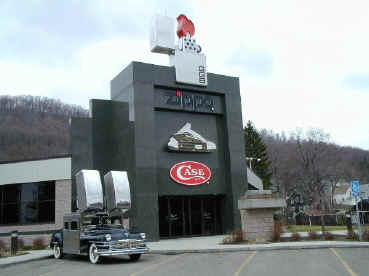 In the early 1950s, Blaisdell asked that the car be
returned to Bradford for an overhaul. Instead, the car was taken to a
Pittsburgh Ford dealer for renovation, which would have proven too
costly. Blaisdell’s enthusiasm for the car fizzled out and the car was
pretty much forgotten about. Several years later when Zippo looked into
the whereabouts of the car, it couldn’t be found. In the early 1950s, Blaisdell asked that the car be
returned to Bradford for an overhaul. Instead, the car was taken to a
Pittsburgh Ford dealer for renovation, which would have proven too
costly. Blaisdell’s enthusiasm for the car fizzled out and the car was
pretty much forgotten about. Several years later when Zippo looked into
the whereabouts of the car, it couldn’t be found.
In 1996, Zippo purchased another 1947 Chrysler New
Yorker Saratoga and started over again, making the car lighter with a
sturdier suspension. The new Zippo Car is just as popular as its
predecessor, making rounds across America, now in a truck instead of
being driven across the nation. When not on the road, the Zippo Car
makes its home at the Zippo/Case Museum in Bradford, Pennsylvania.
Starting in the mid-50s, date codes were stamped on
the bottom of every Zippo lighter. The original purpose was for quality
control, but the codes have since become an invaluable tool for
collectors.
The launch of the Slim model in 1956 was a major
milestone. This version was designed to appeal primarily to women. The
first non-lighter product was a steel pocket tape measure, or
"rule" as it was called, introduced in 1962. Other items have
been added and deleted from the Zippo line since the 1960s. Many were
primarily geared to the promotional products division. The roster
includes key chains, pocket knives, golf greenskeepers, pen-and-pencil
sets and the ZipLight pocket flashlight.
On the music scene, Zippo lighters have been raised
high since the 1960s as a salute to favorite performers, a gesture later
dubbed the "Zippo Moment". The famous Zippo "click"
sound has been sampled on songs, and the lighters themselves have been
featured on album covers, tattooed on rockers’ skin, and wielded in
Rolling Stone photo shoots.
The Vietnam War represented something different from
all other American Wars, previous and since. There were the regular army
soldiers, many raised by World War II heroes and viewing their job as a
duty and privilege. There were victims of fate, the unwilling, drafted
by lottery, many poor and minority, resentful of their government and
military superiors. And there were those along for the ride, not
interested in glory or politics, merely trying to follow orders and earn
their ticket home. Regardless, they were all connected by the Zippo, the
functional tool carried by nearly all soldiers since World War II.
During the Vietnam War, several items became the
canvasses on which soldiers painted their feelings. The Zippo was one of
these items. According to collectors, 200,000 Zippos were used by
American soldiers in Vietnam. Zippo merchandise quickly found its way
onto the black market. Soldiers were able to buy brand new Zippos
without having to go to the PX store. Vietnamese craftsmen would engrave
anything from pictures to phrases onto the Zippo for the soldiers. The
most popular motif engraved on soldiers' Zippo was the map of Vietnam.
Every soldier had his own personalized Zippo, which accompanied him
until the fall of Saigon.
The Zippo played a part in almost every daily
activity of a soldier. The shiny top provided a handy mirror and the
lighter's flame warmed the stew at mealtime. Soldiers kept salt in the
bottom cavities, called canned bottoms, of their Zippos, to replenish
lost body salt. Other legendary Zippos were used to transmit signals or
even provided a shield against enemy bullets. Staff Sergeant Naugle, who
was saved because he was able to signal his position to the rescue
helicopter, had a Zippo in his hand. Among men that had a close call
with death, one of the luckiest was Sergeant Martinez, who kept a Zippo
in his chest pocket. A bullet struck his chest, only to be stopped by
the Zippo. This was reported in Life magazine and also appeared in
various advertisements regardless if it was factual or not.
Zippos were also used in military operations in which
troopers would spray gasoline over the area to burn enemy compounds and
dwellings. Zippos were used so frequently in Search & Destroy
missions that GIs nicknamed them "Zippo Missions" or
"Zippo Raids."
Zippo lighters used by American soldiers during the
Vietnam War have become collector's items. Every Zippo from the war
conveys a great sense of having been there on the battlefield. The
soldiers who faced death and stood on the brink of hell, carrying their
Zippos, transformed these simple lighters into an essential part of
their own bodies and souls. Zippo lighters have since become priceless
collector's items.
In 1982, Zippo celebrated the 50th anniversary of its
lighters, by producing a replica of an early model for the first time.
It was a flat bottomed, solid-brass model and had a diagonally-cut line
on both the top of the lid and the bottom of the case. This was the
reproduction of the 1937 model and came in a box that had the same
design as the one used between 1935 and 1940, which bore the
illustration of the "Windproof Beauty". The Commemorative box
had a gold finish rather than the silver finish from the original. This
reproduction was based on the 1935 prototype box that was not used for
production. The original 1932 Zippos are now very rare.
Zippo’s diverse product line continues to grow, and
now includes lighter accessories; butane candle lighters; watches, men's
and women's fragrance, and lifestyle accessories for men; and the
developing line of heat and flame products for outdoor enthusiasts.
Zippo also owns the Ronson brand of lighters and fuel.
In 2012, during its 80th anniversary year, Zippo
production surpassed the milestone of 500 million lighters since Mr.
Blaisdell crafted the first lighter in early 1933. The lighter is
ingrained in the fabric of both American and global culture.
Today, though most products are simply disposable or
available with limited warranties, the Zippo lighter is still backed by
its famous lifetime guarantee, "It works or we fix it free.™"
In more than 80 years, no one has ever spent a cent on the mechanical
repair of a Zippo lighter regardless of the lighter’s age or
condition. It’s estimated that there are some four million Zippo
collectors in the United States and millions more around the world.
Mr. Blaisdell passed away on October 3, 1978. After
his passing, his daughters inherited the business. Today, George B.
Duke, Mr. Blaisdell’s grandson is the sole owner and Chairman of the
Board. Gregory W. Booth is President and CEO.
The Zippo/Case Museum opened in July 1997. It is
located in Bradford, Pennsylvania at 1932 Zippo Drive. The
15,000-square-foot facility includes a store, museum, and the famous
Zippo Repair Clinic, where the Zippo lighter repair process is on
display. |